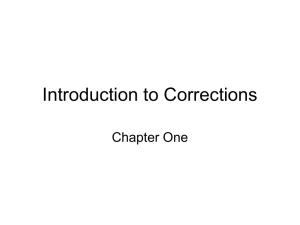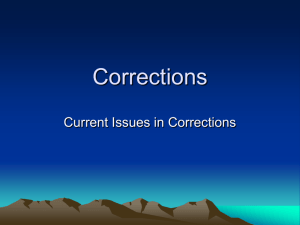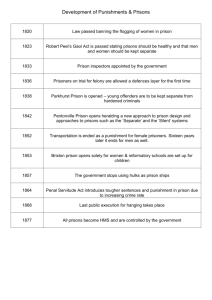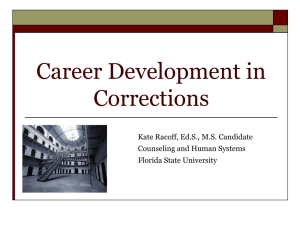Document 18020928
advertisement
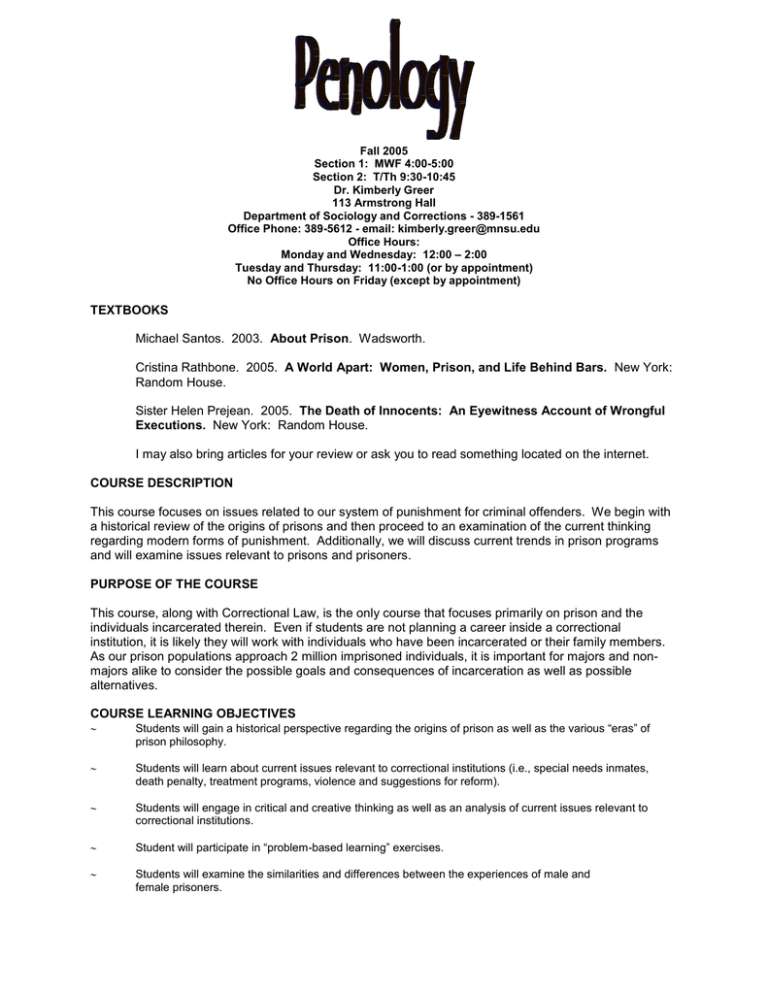
Fall 2005 Section 1: MWF 4:00-5:00 Section 2: T/Th 9:30-10:45 Dr. Kimberly Greer 113 Armstrong Hall Department of Sociology and Corrections - 389-1561 Office Phone: 389-5612 - email: kimberly.greer@mnsu.edu Office Hours: Monday and Wednesday: 12:00 – 2:00 Tuesday and Thursday: 11:00-1:00 (or by appointment) No Office Hours on Friday (except by appointment) TEXTBOOKS Michael Santos. 2003. About Prison. Wadsworth. Cristina Rathbone. 2005. A World Apart: Women, Prison, and Life Behind Bars. New York: Random House. Sister Helen Prejean. 2005. The Death of Innocents: An Eyewitness Account of Wrongful Executions. New York: Random House. I may also bring articles for your review or ask you to read something located on the internet. COURSE DESCRIPTION This course focuses on issues related to our system of punishment for criminal offenders. We begin with a historical review of the origins of prisons and then proceed to an examination of the current thinking regarding modern forms of punishment. Additionally, we will discuss current trends in prison programs and will examine issues relevant to prisons and prisoners. PURPOSE OF THE COURSE This course, along with Correctional Law, is the only course that focuses primarily on prison and the individuals incarcerated therein. Even if students are not planning a career inside a correctional institution, it is likely they will work with individuals who have been incarcerated or their family members. As our prison populations approach 2 million imprisoned individuals, it is important for majors and nonmajors alike to consider the possible goals and consequences of incarceration as well as possible alternatives. COURSE LEARNING OBJECTIVES Students will gain a historical perspective regarding the origins of prison as well as the various “eras” of prison philosophy. Students will learn about current issues relevant to correctional institutions (i.e., special needs inmates, death penalty, treatment programs, violence and suggestions for reform). Students will engage in critical and creative thinking as well as an analysis of current issues relevant to correctional institutions. Student will participate in “problem-based learning” exercises. Students will examine the similarities and differences between the experiences of male and female prisoners. CLASS PARTICIPATION This semester, I am going to try a different teaching strategy that emphasizes students’ involvement in the learning process through a focus on developing critical, creative, and practical thinking. The class, as a whole, will be working on a realistic problem currently faced by correctional institutions. Students will be expected to work in small groups and participate actively in class discussions. Learning encompasses absorbing information through reading and listening, as well as communicating ideas through writing and speaking. Discussion will add diversity to the class, help you think out your ideas, learn to express them clearly to others, and enable you to better comprehend the topic. You should ask questions when you do not understand a point, as well as make comments and level criticisms at ideas that seem inconsistent or contradictory. In addition to meeting this specific corrections program goal, this course also provides opportunities for you to think critically about correctional institutions, and take part in experiential learning opportunities through participation in prison tours and interaction with guest speakers. EVALUATION/GRADES Grades will be based on cumulative points. 2 - Examinations (100 points each) 2 – Book Review (50 points each) 1 – Problem-Based Exercise (MN/Overcrowding) 2 - Summary Papers (20 points each) Total points 200 100 100 40 440 A (90%) 396 - 440 B (80%) 352 - 395 C (70%) 308 - 351 D (60%) 264 – 307 F (59%) 263 and below EXAMINATIONS (200 points) There will be two examinations on the following dates: First Exam: October 21 Final Exam: As scheduled during finals week (this means I do not have the date right in front of me) OPTION REGARDING FINAL EXAM Students who are happy with their grade prior to the final exam can opt out of taking the final and can take the letter grade they have without that final score; however, there are three requirements: (1) you need to discuss your plans with me prior to the final, (2) your attendance between the second exam and the final has to be perfect and, (3) all of your papers and summary papers have to be submitted on time. For testing purposes, students are responsible for all materials in the course, including assigned readings, lectures, videos, handouts, and guest speakers. The exams will consist of a combination of true-false, multiple choice, matching, short answer questions, and essays. No make-up exams will be given except in cases of emergencies; the instructor must be contacted before the scheduled exam. Make up exams for the fall semester will occur on Monday October 31st. I reserve the option to prepare make-up exams that consist only of essay questions. WRITTEN PROJECTS (100 points total) In this class, as in all corrections classes, you will have a portfolio assignment to be completed and included in your portfolio. The portfolio process provides direction for, and documentation of, the attainment of corrections program learning goals. This project will involve two of your assigned texts – (The Death of Innocents and A World Apart). As one of the stated goals of our corrections program is as follows: “students will understand and articulate central concepts in the discipline of corrections including: justice systems, social deviance, crime and delinquency, victimology, intervention strategies, societal reaction to crime and delinquency, social justice and human rights,” it seems appropriate to examine the use of capital punishment and its relationship with the notions of social justice and human rights. Similarly, we (corrections program faculty) want our majors to understand diversity issues. While women continue to make up a smaller proportion of the corrections population, the issues they face have significant ramifications for the field of corrections, and more importantly, the larger society. For this project I ask you to read both books and then prepare two (2) 5 – 7 page summaries of your reflections on the topic of capital punishment and women in prison. You are free to be creative with both book reviews; I am particularly interested in your thoughts on these subjects. For the first book review (capital punishment), I would like for you to reflect on how you think capital punishment as a correctional policy influences the pursuit of social justice and the protection of human rights (therefore, you need to specifically address these points in your paper). You can examine and analyze this text from a number of perspectives; you might want to integrate your analysis of these texts with the documentary (Deadline) which will be shown in class. Some topics you might consider include (these are just ideas to help you get started), but are not limited to, the following: How did Sister Prejean wind up involved with inmates on death row? What are the primary arguments for and against capital punishment? What is Sister Prejean’s perception of capital punishment? In what ways are they different? What ideas/beliefs/assumptions are her beliefs based on? Based on your viewing of the documentary, how would you describe the victims’ families’ reaction to capital punishment? What is the perspective of the correctional staff to executions? How does capital punishment fit with the philosophy of social justice? How does a policy that supports capital punishment promote the protection of human rights? What factors influence people’s perspectives about capital punishment? You can also integrate another book of your choosing on the topic of capital punishment if you would like to compare or contrast perspectives. For the book by Cristina Rathbone, I would like you to consider women’s pathways to prison (what influences their involvement in crime and what contributes to their imprisonment. Other topics you might consider include: o What is life behind bars like for women? Is it different from men’s experiences? o What kinds of treatment should be provided to women in prison if we hope to reduce recidivism rates? o Is prison the appropriate correctional response for the women described in the Rathbone book? What other alternatives might be more effective than imprisonment? o What role do children play in the lives of mothers in prison? Both book reviews should be no less than 5 pages and no longer than 7 pages in length. Points will be assigned based on: articulation of the primary themes of the (what does the author want you to take away with you after reading these books? Incorporating the above list) - 50% reflection/analysis of the topic (your thoughts on the subject/how does this fit with other readings and discussions in class) - 25% ability to write with clarity and precision (25% of the grade) The Women in Prison paper is due: October 14 (section 1) and October 13 (section 2) The Capital Punishment paper is due: November 18 (section 1) and November 17 (section 2) RESEARCH PAPER (Graduate Students Only – 100 points) In addition to the comparison of two of the course texts required of everyone, you will be asked to complete a 20 page research paper focusing on what you believe to be a significant issue facing correctional institutions in the next decade. I would suggest you select a topic in which you have some interest or one that you believe will be useful to your thesis. Before beginning work on this paper, you should discuss your choice of topic with me (so that we can assure that it is appropriate for this class and I may also be able to suggest references). A list of specific expectations for this project, as well as the grading criteria, is attached with this syllabus. You will present your paper to the class on a mutually agreed upon date. This project is worth an additional 100 points for a total of 540 points for graduate students. PROBLEM-BASED LEARNING ASSIGNMENT (100 points) Prisons across the United States are experiencing serious problems with overcrowding; Minnesota is no exception. Minnesota’s prisons are full and many offenders and corrections personnel are now coping with overcrowded living conditions. For example, MCF-Stillwater began double bunking offenders about a year ago and Minnesota recently started placing offenders in the private prison located at Appleton, Minnesota. This problem (of overcrowded correctional institutions) is complicated by a number of factors and is not likely to be solved in the near future. This will be the problem this class grapples with during the spring semester. If Commissioner Joan Fabian gave our class the assignment of studying the growing prison population in Minnesota, exploring various alternatives/options, and preparing a report to her with suggestions for reform at the end of the semester, what would the results of those activities look like? All students begin this project with 100 points; you can only lose points during the course of this exercise. For example, if you miss class on a day when we are working in groups, 10 points will be deducted from your score; if you do not receive an “acceptable grade” from peers in your group at the end of the semester, you will lose 10-20 points; if you fail to complete an assignment related to this project (e.g., locating a research article, submit a written reflection on an assigned topic, or fail to obtain the desired information, 5-10 points will be deducted; or, if you do not participate in discussions related to this problem, points may be lost. On the other hand, if you attend class regularly, complete all assignments, participate actively in solving the problem throughout the semester, you will retain your points. For those students who really get engaged in this project and “go above and beyond expectations,” extra credit points are available. You will find specific grading criteria for this project attached with this syllabus to give you a better understanding of the expectations. I realize this is a different grading strategy, so please let me know if you have any questions. SUMMARY PAPERS (40 points) We have a combination of prison visits, and guest speakers scheduled for this course; you may select two of those experiences about which to write a three page summary paper. Summary papers are worth 20 points each (10 points will be based on content and the remaining points will be based on writing skills). Specifically, I am interested in having you articulate your thoughts about this experience as well as integrate what you have learned in the classroom with what you observe during the field trips or learn from the professionals in the field (i.e., what did you learn, what were your observations, how does this relate with what has been discussed in class or was communicated through the texts, was it a worthwhile learning experience, etc.). Ideally, you should attempt to incorporate information covered during the course. For example, did one of the guest speakers provide new insight that had not been presented in the text or lecture, or vice versa, did some observation you made during a prison tour support something you have read. Summary papers are due within two weeks after the guest speaker or the prison trip. Responsive Learning Environment “Every attempt will be made to accommodate qualified students with disabilities. If you are a student with a documented disability, please see me as early in the semester as possible to discuss the necessary accommodations, and/or contact the Disability Services Office at (507) 389-2825 (v) or 1-800-627-3529 (MRS/TTY).” LETTER TO STUDENTS In closing, I want to welcome you to Penology (CORR 443), a required course for corrections majors. This is one of my favorite courses to teach; I am fascinated by the subject of prisons, the subcultures which develop inside a “total institution,” the strategies offenders employ to cope with the “pains of imprisonment,” policies related to special needs offenders, and issues surrounding capital punishment (to name just a few). I hope you share my enthusiasm for learning about correctional institutions; if you do not, I hope my enthusiasm is contagious. I believe a better learning environment is created when students attend class regularly, are prepared for class, and are willing to engage in an on-going dialogue in the classroom. It is our responsibility, together, to create a comfortable, stimulating environment in which to learn. I give you my word that I will do my best to contribute to such an environment. In addition, I hope you will be willing to take responsibility for developing this learning opportunity as well. If you ever have any questions or concerns about the course, I hope you will feel free to discuss them with me. Kim OUTLINE OF TOPICS TO BE COVERED Topics Origins of Imprisonment Discovery of the Penitentiary and Emergence of Social Control Prison Eras Prisons Today War on Drugs Jails and Jail Overcrowding The Corrections Industry Inmate Experiences and Modern Prisons Correctional Officers Prison Violence/Managing Chaos Gang Management in Corrections Use of Force in Prison Race, Social Class, and Punishment Prisons for Women Riots Special Needs Offenders Death Penalty Boot Camps Institutional Programming Suggestions for Reform Toxic Shame Readings Lecture Notes Michael Santos book and website Lecture Notes and Santos book Lecture Notes Lecture Notes/CCA Website Michael Santos book and website Lecture Notes Lecture Notes Lecture Notes Lecture Notes Cristina Rathbone Video – Doing Time Lecture Notes Prejean Book/Deadline Documentary Lecture Notes/Handouts/DOC Website Lecture Notes Lecture Notes/ Santos Book and Website Lecture Notes Prison trips will be scheduled after the beginning of the semester. I strongly encourage you to attend at least one prison tour; students comment that this represents a learning experience that is impossible to replicate in the classroom. While I hope you will feel comfortable contacting me with any questions you might have, I will ask you to refrain from sending your papers via email. Papers will only be accepted in class, or if you’ve made prior arrangements with me, in my office mailbox. Please let me know if you have any questions about this request.
